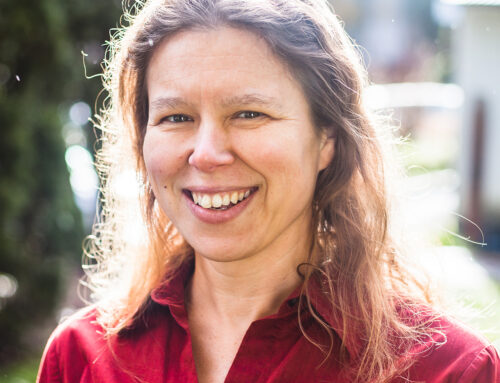As a teacher of math, I am constantly confronted with this question: What has algebra got to do with anything anyway? Most of the time the one asking the question has been me. Why should I teach a subject that no one will ever use, and how can I justify the efforts that I and my students make toward such seemingly useless knowledge? The problem is especially acute when I consider that unless my students pursue a technical career, they will soon forget all about powers and polynomials. If you have been out of school for a long time, then you immediately recognize how much you have forgotten; and if you are still in school, then you need not worry that you will forget it all soon enough.
In the process of justifying the torture I was inflicting upon my students, I arrived at three reasons why we might be inclined to study algebra. The first two traditional responses have never fully eased my troubled conscience. The third, however, provides a light at the end of the tunnel.
Traditional Answers
The first traditional response to the question is, well, tradition. Traditionally, students study algebra in school. My dad did; his dad did, too. I had better fall into line. This is not too bad an answer to the question. The reason why we do most of the things we do is tradition. Have you ever wondered why we go once a year to cut down a perfectly healthy tree, drag it into our house, and watch it make a mess on the floor while it dies? Tradition! With regard to algebra, we simply trust that those who devised curricula for our schools knew what they were doing.
Yet, my gnawing conscience would not let me rest. Times change, and what was worthwhile in the past may no longer be worthwhile in the present. Besides, a Christmas tree gives us warm fuzzy feelings, and algebra does nothing of the sort. I needed to know why algebra was included in the curriculum in the first place.
The second reason for studying algebra is technology. If we are to be citizens of a technological world, then we should have some concept of the basis for that technology. Mathematics is inextricably linked with technology; indeed, knowledge of mathematics is a prerequisite to understanding our technology. Anyone pursuing a career that utilizes technology will have to learn algebra. This is the answer that our government has decided to adopt; “Boys and girls, you must sweat through algebra for the sake of our glorious GNP!”
Everyone does not pursue a technological career, however, so why should those non-technical people study algebra? Many people lead full, rich lives without ever needing to use algebraic formulas (which they do not remember anyway). Furthermore, the general ideas and underlying principles of much of our technology are accessible without resorting to algebra. In the light of these facts, the cogency of the “technological world” argument is weakened for those who do not pursue a technological career.
The third reason for studying algebra—namely, that algebra is a liberal art—is the only reason which in my mind legitimizes teaching algebra in our schools. This reason, however, has been lost from our culture’s consciousness and dialogue. Most of us do not know what the liberal arts are, and since we have lost sight of the meaning and value of the liberal arts, we have lost sight of the value of learning algebra.
A Liberal Art
What does it mean for algebra to be a liberal art? Usually we associate the liberal arts with the humanities—philosophy, language, literature. Classically, however, the liberal arts consisted of those skills necessary for an individual to pursue knowledge and live a good life. They included grammar, rhetoric, logic, music, arithmetic, geometry, and astronomy. Today we would not use these classifications and would perhaps have a different list of the liberal arts, yet the goal remains the same: to aid in the living of a good life. To explain why algebra is a liberal art and why it can be valuable to us, let us first examine geometry.
Geometry is included in the liberal arts because it teaches the student to make clear, precise, analytical arguments from first principles. Geometry is based on the deductive method, a powerful tool used to determine what is true. This method by which one determines if a relation is true is essentially the same for all geometry problems: first, we specify the new relation to be proven;1 then we marshal all the known facts at our disposal;2 and finally, we take simple logical steps toward our goal. These steps follow general rules of reasoning that are applicable to all problems in geometry. The process is sort of like baking a cake: you find a suitably mouthwatering picture in your Joy of Fattening Desserts cookbook; then you check your cupboards for the ingredients; and finally, you take simple steps to make the cake. Naturally, you take into account some general rules of the art of cooking—for example, “whip the batter” does not mean crack a bull whip over the bowl a few times.
Let me illustrate the deductive method with the first proof from Euclid’s 2000-year-old text on geometry. Euclid begins with a set of known facts, or postulates, which are so obvious that we must acquiesce to their truth without proof. For example: (a) between any two points a straight line can be drawn, and (b) about any point a circle can be drawn with a given radius. Euclid also sets out rules of reasoning; for example, (i) if two lines are equal in length to a third line, then they are equal in length to each other. Next he sets out the new relation to be proved: “On a given finite straight line to construct an equilateral triangle.” He then proceeds using only the rules of reasoning and the postulates to construct an equilateral triangle:
- Draw a circle about A with radius AB (postulate b).
- Draw a circle about B with radius AB (postulate b).
- Draw a line from A to C, the intersection of the circles (postulate a).
- Draw a line from B to C (postulate a).
- Since BC is the radius of the circle about B and AB is a radius of the same circle, then AB is equal to BC. Similarly, AC is equal to AB since they are radii of the circle about A.
- BC is equal to AC since BC is equal to AB and AC is equal to AB (rule i).
- Therefore AB = BC = AC, and the triangle is equilateral.
The Greeks must be given great credit for their genius of putting truth seeking into such a clear and elegant formalism as is found in geometry. Until late in the nineteenth century, Euclid’s geometry was seen as the quintessential model for knowledge. Yet, despite their heroic efforts, the Greeks were limited in their mathematics: every step in every proof and problem had to have a concrete geometrical picture associated with it. Some of the pictures were extraordinarily complex, but they were pictures nonetheless.
Not until the Renaissance did mathematics move away from its anchor in concrete pictures, and algebra was born. Algebra differed from geometry by introducing abstract symbols such as ‘x’ and ‘y’. At first the symbols were associated with distances and lengths of lines, so that algebra depended upon geometry for its foundation. Algebra slowly developed a set of assumed facts and its own rules of reasoning, but these facts and rules could still be derived using geometry. Besides representing spatial, geometrical objects, the symbols of algebra also represented numbers. Despite the different meaning of the symbols, the rules and procedures were the same. Thus, the association between symbols and lines or symbols and numbers was lost, and we were left with a new branch of mathematics independent of the meaning of the symbols. Algebra had its rules,3 and it had its given facts and properties of the symbols; and new relations could be found by applying the rules to the known facts and properties.
We can now begin to appreciate the value of studying algebra. Studying algebra can exercise our minds in abstract thinking. It couples the clarity of Euclid’s deductive style with a freedom from bondage to lines, circles, and numbers. Algebra has no pictures associated with the symbols; the symbols are truly abstract, divorced from concrete reality. This feature—the separation from the world of sense perception—is algebra’s greatest strength.4 Manipulating algebraic equations gives us practice in dealing with abstract concepts, and facility with abstract thinking is a highly desirable skill and one not easily obtained.
Practical Pedagogy
Let us back track a moment and recall the goal of a liberal arts education: to learn the skills and knowledge necessary to live a good life. Life is extremely complex, and it requires a great deal of thought to live it well. Often the thought is abstract in nature. Imagine for a moment what life might be like without abstraction. When my son was four, for instance, he had difficulty thinking in abstract terms. Every time the subject of God turned up, he inevitably asked if God was “huger” than so and so, or what God looked like, or where God was. I also asked him on numerous occasions why he misbehaved. He could not tell me because he had no words or concepts to articulate the motives behind his behavior. As adults we are constantly bombarded with concepts that are highly abstract. What is love or justice? What is a trillion dollar debt, and what is its significance? Abstract thought is a common and important aspect of our life—we cannot live without it—and therefore a liberal arts education should invest great effort into the development of abstract analytical skills.
This brings us to pedagogy: How can we best obtain training in abstract analytical skills? It is not at all clear that algebra is the best choice. We could practice abstract thinking in the context of everyday life instead of pursuing the enormous tangent called algebra. And maybe the specific skills obtained in algebra do not transfer into other areas and are not broadly useful, in which case the question remains: What has algebra got to do with anything anyway? Both of these concerns are serious indeed, and they are not easily sorted out.
While I do not pretend to offer the definitive answer to these problems, some progress can be made by considering the following observations. First, we study abstract thinking in the context of algebra because in algebra we can focus better on the skills we are learning. If we were to study concepts such as “justice” or “beauty,” we might become distracted by sorting out presuppositions and language problems. These complications are minimized in algebra. When I was learning to type, I did not start by typing complete sentences but by typing “jjjjjjj kkkkkkk lllllll” and so forth. When I was learning to read, I did not start with Tolstoy but with Dick and Jane. Similarly, studying algebra is a pedagogically superior approach to studying abstract thinking.
With regard to the transferability of skills learned in algebra, I contend that the underlying thinking that occurs in manipulating symbols in algebra is similar to the mental processes involved in all abstract thinking. In algebra, symbols can be manipulated according to certain rules; we are given some initial knowledge about the symbols, and we use that knowledge to generate new equations or relations. To separate out and work with meaningless symbols is a difficult task. It forces us to focus on the rules rather than using our intuition or gut. It can help build the discipline of analyzing by formal structure rather than by intuition.
Similarly, in everyday life, we run across concepts that have no immediate experiential meaning (for example, a “trillion” dollars). Because they are not immediately graspable from experience, we must find a way to work with them in a more formal way. Alternately, sometimes the words we encounter convey different concepts to different people (for example, “democratic”). Finding out which concept is associated with the word in context often requires us to separate the word from our assumed meaning. The same is true with arguments. We run across arguments over ideas of great import, and it is of great benefit to be able to separate the argument from the content to analyze the argument on its own. This is especially true if there are strong commitments on one or both sides of the argument.
To illustrate the process of dealing with abstract concepts, let me introduce #!@*$!. “What in the world is #!@*$!?” you ask. Excellent question; I was hoping you would ask. #!@*$! is all around us; it is inside us and outside us. We cannot grab #!@*$!, but we can feel it. If #!@*$! were missing, we could not live.
At this point, we have a group of symbols, #!@*$!, to which we have attached certain properties but no concrete image.5 Given a more exact description and repeated usage we might develop an understanding of the meaning of #!@*$! and be able to use it in our thoughts and speech. The way we learn the meaning of #!@*$! is identical to how we learn math concepts. Just as ‘y’ might be defined in terms of an equation with ‘x’, #!@*$! is defined in terms of words such as “inside,” “grab,” “missing,” and “live.” Just as ‘y’ has no concrete image associated with it, #!@*$! has no concrete image associated with it. Thus, manipulating x’s and y’s trains us in those processes we use in forming abstract concepts.
Conclusion
We began by asking, “What does algebra have to do with anything anyway?” Perhaps a more common and more indicative version of this concern runs something like this: “I took algebra in high school, but I have never used it. All of the knowledge gained was for naught. (Sigh!)” This criticism has considerable force in our society precisely because we have changed the focus of education from skills to employment oriented knowledge. In the knowledge race, algebra is at the back of the pack—at least for non-technical students. But those very same non-technical students need to practice abstract analytical skills more than anyone. If we re-align our educational vision back to its traditional goals and restore the emphasis on disciplined reasoning skills, algebra comes out smelling like a rose. Ω
Notes:
1 In a modern geometry class, the new relation might be a problem at the end of the chapter. In Greek times, however, new relations were probably guessed at based upon experience and common sense.
2 In this case, the known facts would be all of the theorems that have already been proven.
3 The rules of algebra are things like the “associative rule” and the “distributive rule.”
4 If you are thinking at this point, “Whew, this guy is a real nut,” then you are undoubtedly in good company. Read on, and maybe we can crack the nut to get to the meat.
5 It is interesting that “air,” “heat,” and “love” would all fit the description given. Perhaps there are others as well.







